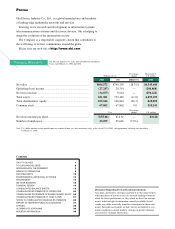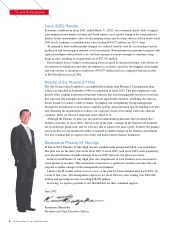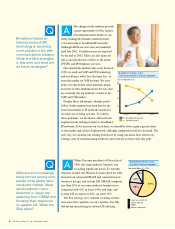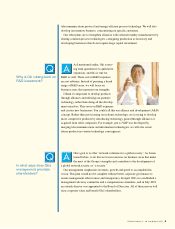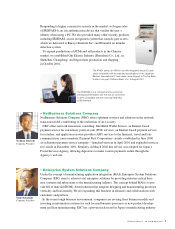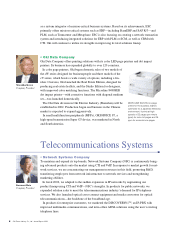Oki 2002 Annual Report Download - page 6
Download and view the complete annual report
Please find page 6 of the 2002 Oki annual report below. You can navigate through the pages in the report by either clicking on the pages listed below, or by using the keyword search tool below to find specific information within the annual report.
Oki Electric Industry Co., Ltd. Annual Report 20024
The changes in the industry provide
a great opportunity for Oki. Japan’s
telecommunications market is cur-
rently making the dramatic transition from
voice networks to broadband IP networks.
Although ADSL services were not launched
until late 2001, 10 million users are expected
by the end of 2002. There are also plans for
full-scale introduction of fiber-to-the-home
(FTTH) and IP telephony services.
Oki entered this market fairly early. In fiscal
1998, we used our VoIP and CTI technology
and our alliance with Cisco Systems, Inc., to
enter the market for VoIP systems. We were
able to do this before other domestic manu-
facturers of telecommunications devices and
are currently the top domestic vendor in the
VoIP and CTI market.
Despite these advantages, though, profit-
ability in this segment has been hurt by up-
front investments in IP networks and lower
revenues for existing systems. To combat
these problems, we decided to shift network
engineers from existing systems to broadband
IP networks. If we increase our focus here, we should be able to gain a greater share
of the market and achieve high growth, although competition will also be harsh. The
only way we can keep our leading position is by using our know-how effectively.
Cutting costs by manufacturing hardware and software overseas will also help.
Broadband based on
Internet protocol (IP)
technology is becoming
more popular in the tele-
communications industry.
What are Oki’s strengths
in this area and what are
its future strategies?
QA
Alliances are increasingly
being formed among com-
panies in the global semi-
conductor market. Most
semiconductor manu-
facturers in Japan are
switching from DRAM and
focusing their resources
on system LSI. What are
Oki’s plans?
QWhen I became president of Oki in fiscal
1999, the semiconductor business was
recording significant losses. To turn this
situation around, our Phoenix 21 plan called for with-
drawal from advanced DRAM and concentration of
resources in logic and system LSI. DRAM comprises
less than 20% of our semiconductor business now,
compared with 50% in fiscal 1999, and logic and
system LSI accounts for 60%, up from 30%.
The best strategy is to continue focusing on busi-
ness areas that capitalize on our expertise. For Oki,
that means specializing in system LSI utilizing
A
57%
20%
15%
8%
Breakdown of Sales in the
Electronic Devices Segment
Logic and system LSI
Year ended March 31, 2002
System memory
DRAM
Optical components
0
20
40
60
80
(%)
2000 2001 2002
Broadband IP networks
Existing systems
Breakdown of Sales in the
Telecommunications Systems Segment
Years ended March 31
Oki Electric Industry Co., Ltd. Annual Report 20024


